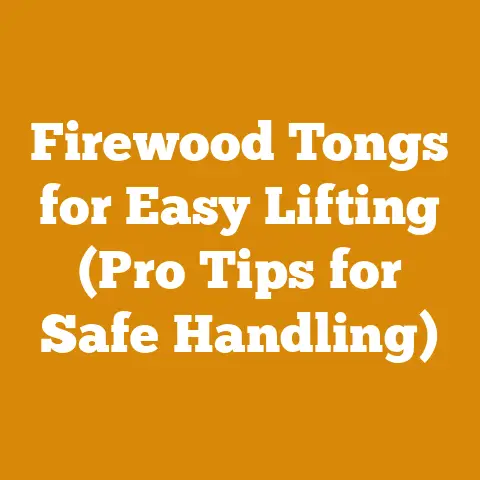Price of Walnut Logs (5 Expert Tips for Accurate BF Valuation)
Alright, let’s dive into the fascinating, and sometimes perplexing, world of walnut log pricing! Want a quick fix? Here’s a cheat sheet: Clean, straight, knot-free logs fetch the best prices. But if it were that simple, you wouldn’t be here, right? Let’s get into the nitty-gritty of accurately valuing black walnut logs.
Price of Walnut Logs: 5 Expert Tips for Accurate BF Valuation
Pricing walnut logs is as much an art as it is a science. I’ve spent years walking timber, sizing up logs, and negotiating deals with everyone from small-scale hobbyists to large lumber mills. I’ve seen firsthand how a misjudgment can cost you money, and how a keen eye can turn a seemingly average log into a profitable asset. So, let’s get started.
1. Master the Board Foot (BF) Measurement: More Than Just Numbers
The board foot (BF) is the language of the lumber industry. It’s the foundation upon which log values are built. One board foot is defined as a piece of wood 1 inch thick, 12 inches wide, and 12 inches long. Seems simple enough, right? But the devil’s in the details.
-
How to Calculate Board Feet: There are several methods, but the most common for standing timber and logs is the Doyle Log Scale. Other scales exist, such as the Scribner and International, but Doyle tends to be the most widely used, especially in my neck of the woods (Midwest USA). The formula looks like this:
BF = (D - 4)² * L / 16
Where:
D= Diameter of the log inside the bark (in inches) at the small endL= Length of the log (in feet)
Let’s break that down with an example. Say you have a walnut log that’s 12 feet long and has a diameter of 16 inches at the small end.
BF = (16 - 4)² * 12 / 16BF = (12)² * 12 / 16BF = 144 * 12 / 16BF = 1728 / 16BF = 108
So, that log contains approximately 108 board feet according to the Doyle Log Scale.
-
Why Accuracy Matters: A slight miscalculation in diameter can significantly impact the BF, and therefore the price. Always measure carefully, and use the smallest diameter inside the bark. It’s better to underestimate slightly than to overestimate and be disappointed. Remember that the Doyle scale tends to underestimate the actual yield, especially for smaller logs. This is something buyers often factor in.
-
Beyond the Formula: Understanding the formula is only half the battle. You need to be proficient at visually estimating BF. This comes with practice. Get out there, measure logs, and compare your estimations with the calculated BF. Over time, you’ll develop a “feel” for it.
-
Data Point: Studies have shown that experienced timber cruisers can estimate BF within 10% accuracy 80% of the time. This highlights the importance of experience and continuous learning.
2. Grade Like a Pro: Unlocking the Value Hidden Within
Grading is where the real magic (or heartache) happens. Walnut logs are graded based on a variety of factors, primarily the presence of defects. The higher the grade, the fewer defects, and the greater the potential for high-quality lumber. Here’s a rundown of common grades:
- Prime: These are the cream of the crop. Prime logs are typically large, straight, and virtually knot-free. They are highly sought after for veneer and high-end furniture.
- #1 Sawlog: Excellent quality logs with minimal defects. Still very valuable and suitable for a wide range of applications.
- #2 Sawlog: These logs have more defects than #1 sawlogs, such as knots, sweep (curvature), and rot. They are still usable but will yield a lower percentage of clear lumber.
- #3 Sawlog: The lowest grade of sawlog. These logs have significant defects and are often used for pallet lumber or other less demanding applications.
-
Cull: These logs are essentially worthless for lumber production due to excessive defects. They may be used for firewood or other low-value purposes.
-
Key Grading Factors:
- Diameter: Larger diameters generally command higher prices, especially for prime logs. This is because larger logs yield wider, more valuable boards. A log with a small diameter may only yield a few narrow boards, limiting its potential use.
- Length: Longer logs are generally more desirable as they allow for longer, more continuous pieces of lumber.
- Straightness: Straight logs are easier to process and yield more usable lumber. Sweep and crook reduce the potential yield and can make processing more difficult.
- Knots: Knots are a major defect that reduces the strength and aesthetic appeal of lumber. The size, number, and distribution of knots all affect the grade. Dead knots (loose knots) are particularly problematic.
- Rot: Rot is a serious defect that can significantly weaken the wood and make it unusable. Even small amounts of rot can downgrade a log.
- Shake: Shake refers to a separation of the wood fibers along the growth rings. This can weaken the wood and make it prone to splitting.
- Stain: While not always a structural defect, stain can affect the aesthetic appeal of the wood, particularly for applications where a uniform color is desired.
-
My Personal Experience: I remember one time I was offered a “steal” on a walnut log. It looked impressive from a distance – large diameter, decent length. But upon closer inspection, I noticed a subtle bulge on one side. I probed it with my axe, and sure enough, it was hiding a massive pocket of rot. Had I not been careful, I would have paid for a log that was essentially worthless.
-
Unique Insight: Don’t be afraid to get your hands dirty. Probe for rot with an axe or increment borer. Look for subtle signs of hidden defects. The more you inspect, the better you’ll become at grading.
-
Data Point: A study by Purdue University found that accurate grading can increase the value of a walnut log by as much as 50%. This underscores the importance of mastering this skill.
3. Know Your Market: Location, Location, Location
The price of walnut logs isn’t just determined by their quality; it’s also heavily influenced by market demand. What’s considered a fair price in one region might be a rip-off in another.
-
Local vs. Global Markets: Are you selling to a local sawmill, a veneer buyer, or exporting internationally? Each market has its own set of demands and pricing structures. Local sawmills may be more forgiving of minor defects, while veneer buyers are incredibly selective. Export markets often pay premium prices for high-quality logs, but transportation costs can eat into your profits.
-
Understanding Demand Drivers: What are the current trends in the furniture and woodworking industries? Is there a high demand for walnut furniture, flooring, or veneer? Are there any specific projects or events that are driving up demand (e.g., a large-scale construction project using walnut paneling)?
-
Building Relationships: Cultivate relationships with local sawmills, veneer buyers, and timber brokers. These relationships can provide you with valuable market insights and ensure that you get a fair price for your logs. Don’t be afraid to ask questions and learn from their experience.
-
The Power of Networking: I once attended a timber auction where I met a buyer from a high-end furniture manufacturer. He was specifically looking for walnut logs with a unique figure (grain pattern). I happened to have a log with a similar figure back at my property. I contacted him after the auction, and we negotiated a price that was significantly higher than what I would have gotten from a local sawmill.
-
Unique Insight: Market research is crucial. Spend time online researching current trends in the lumber industry. Attend timber auctions and industry events to network with buyers and learn about market demands.
-
Data Point: According to the USDA Forest Service, the demand for hardwood lumber has been steadily increasing over the past decade, driven by factors such as population growth and increased construction activity. This suggests that the market for walnut logs will remain strong in the foreseeable future.
4. Negotiate Like a Pro: It’s More Than Just a Number
Negotiation is an art form, and it’s a critical skill for getting the best price for your walnut logs. Don’t just accept the first offer you receive. Be prepared to negotiate and know your bottom line.
-
Know Your Value: Before you start negotiating, have a clear understanding of the value of your logs. This includes the BF, grade, and market demand. Don’t be afraid to ask for a higher price if you believe your logs are worth it.
-
Be Prepared to Walk Away: The ability to walk away from a deal is a powerful negotiating tool. If the buyer isn’t willing to meet your price, be prepared to move on to another buyer.
-
Listen Carefully: Pay attention to what the buyer is saying. What are their needs and priorities? Are they looking for specific grades or sizes of logs? Understanding their perspective can help you tailor your offer and increase your chances of success.
-
The Art of the Counteroffer: Never accept the first offer. Always make a counteroffer, even if it’s only slightly higher than your original asking price. This shows the buyer that you’re serious about negotiating and that you’re not willing to settle for less than what your logs are worth.
-
My Toughest Negotiation: I once spent an entire day negotiating the price of a single walnut log. The buyer was adamant about paying a low price, citing minor defects. I stood my ground, arguing that the log’s overall quality and potential for veneer outweighed the minor flaws. Finally, after hours of back-and-forth, we reached a compromise that I was happy with. The key was to remain calm, persistent, and confident in the value of my product.
-
Unique Insight: Don’t be afraid to get creative. Consider offering discounts for volume purchases or offering to deliver the logs to the buyer’s location.
-
Data Point: A study by Harvard Business School found that skilled negotiators can increase the value of a deal by as much as 20%. This highlights the importance of honing your negotiation skills.
5. Understand Regional Price Variations: Geography Matters
Walnut log prices are not uniform across the globe. They vary significantly based on location, species, and local market conditions. What might be a fair price in the Midwest United States could be drastically different in Europe or Asia.
-
Species Matters: While Juglans nigra (Black Walnut) is the most commercially valuable, other walnut species exist. Their value depends on factors like color, grain, and workability. Claro walnut, for example, is prized for its unique figure and commands high prices.
-
Local Market Dynamics: Transportation costs play a significant role. If you’re far from processing facilities, the price will likely be lower to compensate for the added expense of hauling logs. Local regulations, such as logging restrictions or environmental regulations, can also impact prices.
-
International Trade: Global demand can influence local prices. For example, if there’s a surge in demand for walnut veneer in China, it could drive up prices in the United States, even if local demand remains stable.
-
Case Study: Midwest vs. Pacific Northwest: In the Midwest, Black Walnut is relatively common, which can keep prices competitive. However, the Pacific Northwest, with its abundance of other valuable hardwoods, might see lower prices for walnut simply due to less demand and different market priorities.
-
Unique Insight: Stay informed about regional price trends by subscribing to industry publications, attending timber sales, and networking with local forestry professionals. Don’t rely solely on online price guides, as they may not accurately reflect local market conditions.
-
Data Point: According to a report by the Food and Agriculture Organization of the United Nations (FAO), timber prices in Europe have been steadily increasing in recent years, driven by factors such as increased demand for sustainable wood products and stricter environmental regulations. This trend could eventually impact walnut log prices in other regions as well.
Bonus Tips for Maximizing Walnut Log Value
Beyond the core strategies, a few extra pointers can significantly boost your returns:
- Proper Harvesting Techniques: Avoid damaging the logs during felling and skidding. Minimize bark damage, as this can lead to staining and degrade the wood.
- Prompt Processing: Don’t let logs sit for extended periods, especially in warm, humid conditions. This can lead to fungal growth and insect damage, which will lower their value.
- Kiln Drying (If Applicable): If you have the means to kiln-dry the lumber, you can add significant value. Kiln-dried lumber is more stable and less prone to warping and cracking.
- Sustainable Forestry Practices: Implementing sustainable forestry practices can enhance the long-term value of your timber and attract environmentally conscious buyers.
- Documentation is Key: Keep detailed records of your logs, including measurements, grades, and sale prices. This information will be invaluable for future transactions and for tracking your profitability.
Common Mistakes to Avoid
- Ignoring Defects: Don’t underestimate the impact of defects on log value. Be honest and accurate in your grading.
- Overpricing: Setting an unrealistic price will scare away potential buyers. Be realistic and base your price on market conditions and the quality of your logs.
- Lack of Communication: Keep the lines of communication open with potential buyers. Respond promptly to inquiries and be willing to answer their questions.
- Neglecting Safety: Always prioritize safety when handling logs. Use appropriate personal protective equipment (PPE) and follow safe work practices.
- Failing to Seek Expert Advice: If you’re unsure about any aspect of log valuation or negotiation, don’t hesitate to seek advice from a qualified forestry professional or timber broker.
Conclusion: The Art and Science of Walnut Log Pricing
Pricing walnut logs is a complex process that requires a combination of knowledge, experience, and skill. By mastering the board foot measurement, learning to grade like a pro, understanding market dynamics, negotiating effectively, and staying informed about regional price variations, you can significantly increase your chances of getting a fair price for your logs. Remember, it’s not just about the numbers; it’s about building relationships, staying informed, and always being willing to learn. So get out there, walk the timber, and good luck!






